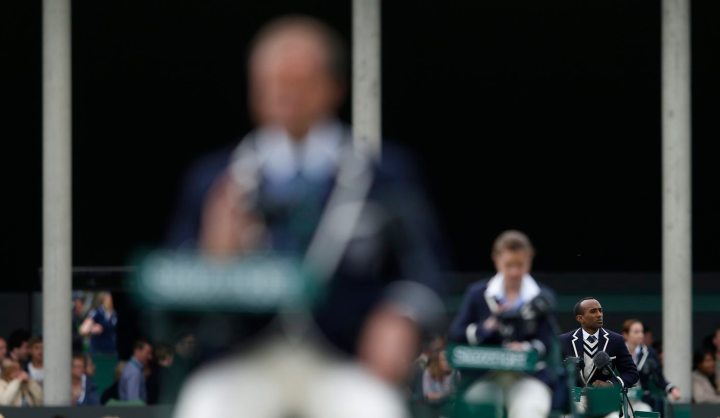Sport
What cricket can learn from tennis

Cricket and tennis don’t have a lot in common, other than players playing in white and the fact that a game can go on for ages before a winner is decided. They do, of course, also share a certain kind of technology which challenges certain decisions. Cricket can take a lot from the way the review system is used in tennis. BY ANTOINETTE MULLER.
Even those with marginal interest in tennis must have found themselves at least somewhat intrigued by Wimbledon over the last few days. The All England Club’s courts have been gobbling up victims in an injury frenzy which saw seven players opt out on the third day. The little guys have been conquering the big guns and even those who don’t understand the sport will have been enamoured by Dustin Brown getting all welled up after he beat Lleyton Hewitt.
It’s been an enthralling view days, a perfect script for a massive tournament. Cricket, though, can learn a lot from Wimbledon and tennis as a whole. The way the review system is used in tennis is the most notable lesson, but there are other subtle takeaways from the competition.
Firstly, players at Wimbledon have been dropping like flies through injury. When you’re injured in a competition, you’re out. That, of course, is somewhat similar when it comes to cricket and it’s especially true in the case of batsmen who are no longer allowed runners. However, there are still far too many allowances for sub fielders and bowlers taking breaks for body management. It’s not easy to say who is faking and who genuinely can be substituted, but cricket lends itself to far too many double standards, even when it comes to playing conditions for injured players. Even soccer doesn’t allow more than three substitutions in a match. If a fielder or a bowler gets injured and cannot continue, they should not be allowed a substitute fielder while they are off for treatment. Many batsmen and bowlers have battled on bravely, through broken bones and bleeding toes, but substitutions are often misused by the fielding side and the double standards are unnecessary.
Secondly, and possibly the most debated of the lot: the magic of the decision review system. Cricket’s Decision Review system has been and most likely will still be debated for some time. Its accuracy, the effect it has on the umpire’s responsibility and the way it is used by players are all factors. Cricket is a sport packed with nous – not to say tennis is not – but its use of a video technology is far more curtailed than in cricket. In tennis, when a referral is used, the decision is immediate, precise, transparent and it is accepted by everyone.
The use of DRS in cricket still has not been implemented across the board for a variety of reasons. Some boards own it, some boards don’t. It costs a lot of money and even if Hawk-eye were developed specifically for cricket, it seems to now cause more contention than calm. Tennis only started to use the system in 2006 and the system was tweaked and tinkered until the uniformed system was employed in 2008.
Cricket needs a far more intricate and refined use of the review system, it needs more angles, more cameras, Hot-Spot and a whole host of other technology in order to make sure the system is used properly – and it’s expensive. Two cameras set teams back $6,000 per day and a further $10,000 for a four-camera set-up – with additional costs to include the Hot-Spot. That’s a lot of money to shell out for a system that’s not even always accurate.
The two sports use the system for very different reasons, of course. Tennis wants to know if the ball was out or not. Cricket needs a far more intricate and refined use of the review system. In cricket, one wants to know where the ball pitched, how much it turned, whether there was an edge and whether the on-field decision can be overruled based on the evidence available to the third umpire.
The accuracy of the technology has been debated to no end, too, and comparing the use of technology for the two sports is massively naïve, but cricket can take away some of the basic rule used in tennis, especially in how it is used by players.
Cricket’s use of the DRS has changed. Instead of using the system to overturn howlers, players have started to use it “strategically”. That was never part of the plan, yet it is now used as such in certain cases and that’s perhaps where one of the biggest problems lie.
Instead of accepting a marginal leg-before decision, when teams find themselves in a bit of a sticky position, they often opt for the “tactical” review in the hope that there is some sort of marginal error which goes in their favour and gives them a second life. That’s not how the system was intended to be used and it could even be argued that this kind of use by the players has made umpires more slack. Umpires, perhaps, don’t stay as focused as they used to because they know they can get away with it, since players will sometimes challenge even marginal decisions.
There is one simple solution to it all. Take reviewing leg-before decisions out of the equation by handing over the decision of whether they are out or not to the third umpire in all cases. This eliminates the dreaded “umpire’s call” controversy and stops wasting time messing around with “tactical reviews”.
Make sure the process of deciding whether the player is out or not is transparent, displayed on the screens around the ground, and make sure it is quick. There are laws in place for what constitutes leg-before, so use them, enforce them and stop wasting everybody’s time. DM
Photo: Umpires sit on outside courts at the Wimbledon Tennis Championships, in London June 24, 2013. REUTERS/Eddie Keogh



















 Become an Insider
Become an Insider